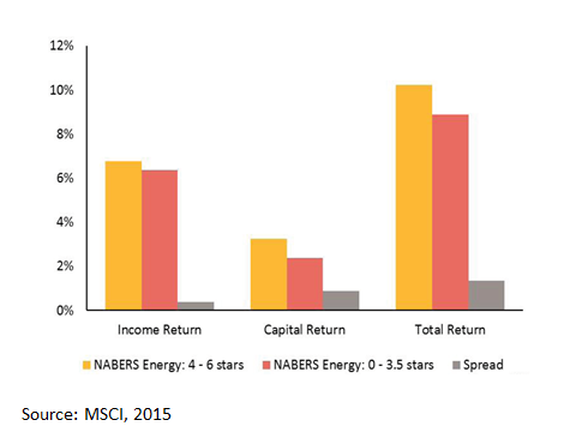The commercial value of an optimised building
There is growing acknowledgement that value of an energy efficient building goes beyond the cost of the energy saved, with particular attention paid to health and well-being and the consequences on productivity. But even that is far from the full extent of the potential value.
What is the potential value if we start from the perspective of a commercial office landlord and their ultimate commercial drivers?:
- Rental profit
- Asset value
- Securing investment
1. Rental profit
Let us consider the 2 parts of rental profit equation: rental income & operational cost.
Rental income.
To sustain an energy efficient building requires continuous monitoring of its operation and that attention should also ensure that the building is well run in terms of occupant comfort, with reduced complaints. Though it wouldn’t be a primary consideration there is at least a legitimate argument that at the margins, improved comfort could influence a tenant’s decision to extend a lease, avoiding a void. It may also influence their acceptance of rent increases.
If a landlord’s reputation for delivering proven, well performing buildings is established (in terms of low energy use and comfort) there is also a case that this could influence the attraction of new tenants, further reducing voids. This may be both because of the prospective tenant’s own corporate energy ambitions and the comfort and productive benefits to their staff.
Operational cost
Perhaps counter-intuitively the attention required to sustain an efficient building also has the potential to improve maintenance efficiency. The prevalent approach to maintenance is ‘planned preventative maintenance’ where equipment is checked at a predetermined frequency, independent of actual operational performance. Performance data monitored to ensure efficient operation can also be used to target maintenance resource (both time and budgets) more efficiently. A ‘condition based maintenance’ approach can be taken where the frequency of checks are influenced by actual equipment performance. Actual performance could also be considered when replacing equipment, extending the lifetime of equipment that still performs well.
Another opportunity to reduce operational cost is to apportion landlord energy costs directly to tenants (also making a tenant’s energy costs a fairer reflection of use). Where sub-metering of landlord and tenant energy usage is present and used to monitor operational performance, if the sub-meters are of sufficient accuracy, they may also be used to apportion landlord energy costs. These costs can therefore be removed from the service charge.
2. Asset Value
Improvement in rental income should also, in time, increase the asset value as the improved income potential is acknowledged. A well performing building may also be seen as a broader marker of quality.
This relationship between performance, rental income and asset value is already well established in Australia. This has been assisted by the NABERS rating scheme which has established a trusted, transparent indication of the actual operational energy efficiency of a building (unlike Energy Performance Certificates in the UK which derive from a model of theoretical energy performance). A building verified as more efficient achieves a higher star rating.
Annualised returns to March 2015 for NABERS office energy ratings central business district markets.

The numbers involved mean these seemingly small percentage differences translate to tens of thousands, to potentially millions of pounds.
There are movements in the UK towards the establishment of a similar operational rating, including through separate initiatives by UK GBC, Better Buildings Partnership and BRE. It seems credible that if this is established, it will strengthen the link in the UK (and other countries where such an approach is adopted) between performance, rental income and asset value. Conversely, as scrutiny on operational performance grows, there is even a risk that buildings become stranded assets.
3. Securing Investment
Another very real commercial benefit is securing investment. Investor demands that buildings they invest in are energy efficient are growing. Therefore demonstrating a track record in delivering and sustaining high performing, energy efficient buildings has increased potential to influence whether or not investment is secured.
Why is this value not fully recognised?
There are multiple, complex and historic reasons why the full value of an efficient building are not properly recognised in the UK. The following are 3 key ones:
- Historic disinterest Though there has been a steady change over the last 15 or so years, for a long time, the energy performance of buildings has been of minor concern. And though there has been change, including through sincere ambition from high end office landlords, there is a legacy in how this disinterest has become embedded in the design, construction and operational supply chain that we are still grappling with.
- Focus on energy cost savings When energy efficient measures are considered the tendency has been to judge their value solely on the energy costs saved (and the pay-back as a result). Energy costs savings are easier to estimate through engineering calculations that the other value considered here. Regulation around service charges also encourages this narrow, distorted perspective of value.
- Lack of transparency As mentioned above in the UK, and many other countries, there is not an established, trusted measure of operational performance. As a consequence there is not a trusted way for a landlord to demonstrate to the market that their buildings are truly high performing. Instead, there is a confusing fog of incomparable claims.
The rhetoric in the market is very clearly that high performing buildings should be high value buildings. If initiatives to establish transparent measures of performance are successful, the potential to back this rhetoric up with evidence will grow.
It seems inevitable that this link will grow. Remaining questions are: How fast will this be? and Will landlords do enough in advance of this change to take full commercial value advantage (or otherwise risk assets that become increasingly devalued)?
Find out more about our Building Optimisation Service.
Further articles that may be of interest:
Building Optimisation plays a lead role in world-leading market transformation